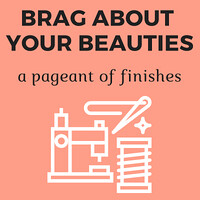My latest pattern—Irish Twist—just released into the world! It’s a quick-to-sew pattern that’s great for beginners and more seasoned quilters alike. (Get your copy here!)
Irish Twist is a whole-composition design—that is, the different sizes are created by enlarging the pieces, not by adding more blocks. In other words, you won’t make a bunch of identical blocks and have the luxury of settling on a layout for them once they’re all sewn. Irish Twist requires a plan from the get-go.
The pattern includes a coloring page to help you design your quilt top. Before you take your colored pencils to paper, however, there are a few things to think about ...
Playing with Value in the Quilt Top
It may be helpful to consider the value of the fabrics you’ll be working with. The three examples below all use the same fabrics (Nova by Basic Grey for Moda Fabrics) but distribute value differently in the quilt.
The high-volume fabrics in these examples include the cranberry fabric and two deep blue fabrics. The low-volume fabric is the small floral with a white background. Everything else can be described as a mid-tone. The black and white versions of each design help in observing these discrepancies in value.
Example 1, which is the pattern’s cover quilt, concentrates the high volumes in the corners and in a large diamond in the center of the quilt. (I hope that description makes sense! It’s what I see when I look at it!) The low-volume fabric is sprinkled along each edge. (In the pattern’s terms, fabrics C, E, and G are high volume; F is low volume.)
Example 2 uses high volumes around the entire perimeter and a creates a small X of them in the center. The low-volume fabric appears in four blocks just beyond that X. (In the pattern’s terms, fabrics B, F, and G are high volume; C is low volume.)
Example 3 concentrates the high volumes in a small diamond in the center of the quilt and sprinkles them along each edge. Chunks of the low-volume fabric are adjacent to each of the four corners. (In the pattern’s terms, fabrics A, B, and F are high volume; D is low volume.)
You may not think about a fabric pull and the subsequent placement in such terms, but you might decide that you like the look of one of these examples over the others and want to recreate the value distribution similarly in your own project.
Another place to go to for ideas on palettes and fabric placement is Instagram. My testing crew has already used #IrishTwistQuilt to post pictures of their projects, and wow, there are color and fabric combinations I would never have thought of myself. Check their pictures out here!
An Alternative to the Coloring Page
As mentioned earlier, the Irish Twist pattern comes with a coloring page. If you find that plotting a quilt top with a coloring page is effective, go for it! I rarely use coloring pages, and for this particular pattern, there’s a more effective way to evaluate potential fabrics.
Irish Twist’s cutting instructions include a large square and a small square. Using the small square dimensions for the quilt size you want to make (the small square size is different for each), cut a square for each of the shapes in the pattern top, including the half-shapes along the edge. In other words, for example 3, above, cut 4 of the cranberry floral, 4 of the teal geometric, 8 of the low-volume floral, 8 of the navy floral along the edges, etc. You will cut 49 squares in all.
Use the pattern to lay them out on point to get an idea of how they play together. I’ll be using a white background fabric, so I placed mine on a piece of white batting and then took a picture. (That way, I can view it in grayscale if I want.)
Example 1 in 2-inch squares looks like this ...
Pretty cool, right? This exercise can help you get a better idea of what your final quilt top will look like without wasting any fabric. Because I am making a baby-size quilt, I cut 2-inch squares and will use them in my actual project.
Questions? Comments?
This post is just food for thought. There’s no right or wrong way to plot your Irish Twist. And I suspect you already evaluate fabrics placement in an intuitive way, without thinking, Hey, I’m using a low volume here!
I’d love to hear your thoughts on selecting and placing fabrics for this pattern. Leave a comment, whether I’ve confused you (!) or got you thinking.
Heads-up! If you comment anonymously, I will not be able to respond to you via email. Likewise, if you’re a no-reply blogger, I won’t have access to your email address. You can always include your email in the comment or send your email address to frombolttobeauty [at] gmail [dot] com.
Thanks!
**Get your copy of Irish Twist here**















